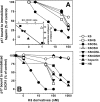Molecular interaction studies of HIV-1 matrix protein p17 and heparin: identification of the heparin-binding motif of p17 as a target for the development of multitarget antagonists
- PMID: 23166320
- PMCID: PMC3542999
- DOI: 10.1074/jbc.M112.400077
Molecular interaction studies of HIV-1 matrix protein p17 and heparin: identification of the heparin-binding motif of p17 as a target for the development of multitarget antagonists
Abstract
Once released by HIV(+) cells, p17 binds heparan sulfate proteoglycans (HSPGs) and CXCR1 on leukocytes causing their dysfunction. By exploiting an approach integrating computational modeling, site-directed mutagenesis of p17, chemical desulfation of heparin, and surface plasmon resonance, we characterized the interaction of p17 with heparin, a HSPG structural analog, and CXCR1. p17 binds to heparin with an affinity (K(d) = 190 nm) that is similar to those of other heparin-binding viral proteins. Two stretches of basic amino acids (basic motifs) are present in p17 N and C termini. Neutralization (Arg→Ala substitution) of the N-terminal, but not of the C-terminal basic motif, causes the loss of p17 heparin-binding capacity. The N-terminal heparin-binding motif of p17 partially overlaps the CXCR1-binding domain. Accordingly, its neutralization prevents also p17 binding to the chemochine receptor. Competition experiments demonstrated that free heparin and heparan sulfate (HS), but not selectively 2-O-, 6-O-, and N-O desulfated heparins, prevent p17 binding to substrate-immobilized heparin, indicating that the sulfate groups of the glycosaminoglycan mediate p17 interaction. Evaluation of the p17 antagonist activity of a panel of biotechnological heparins derived by chemical sulfation of the Escherichia coli K5 polysaccharide revealed that the highly N,O-sulfated derivative prevents the binding of p17 to both heparin and CXCR1, thus inhibiting p17-driven chemotactic migration of human monocytes with an efficiency that is higher than those of heparin and HS. Here, we characterized at a molecular level the interaction of p17 with its cellular receptors, laying the basis for the development of heparin-mimicking p17 antagonists.
Figures







Similar articles
-
Heparin and heparan sulfate proteoglycans promote HIV-1 p17 matrix protein oligomerization: computational, biochemical and biological implications.Sci Rep. 2019 Oct 31;9(1):15768. doi: 10.1038/s41598-019-52201-w. Sci Rep. 2019. PMID: 31673058 Free PMC article.
-
Simian immunodeficiency virus and human immunodeficiency virus type 1 matrix proteins specify different capabilities to modulate B cell growth.J Virol. 2014 May;88(10):5706-17. doi: 10.1128/JVI.03142-13. Epub 2014 Mar 12. J Virol. 2014. PMID: 24623414 Free PMC article.
-
HIV-1 matrix protein p17 binds to the IL-8 receptor CXCR1 and shows IL-8-like chemokine activity on monocytes through Rho/ROCK activation.Blood. 2012 Mar 8;119(10):2274-83. doi: 10.1182/blood-2011-06-364083. Epub 2012 Jan 18. Blood. 2012. PMID: 22262769
-
HIV-1 Matrix Protein p17 and its Receptors.Curr Drug Targets. 2016;17(1):23-32. doi: 10.2174/1389450116666150825110840. Curr Drug Targets. 2016. PMID: 26302809 Review.
-
Preparation of regioselectively 6-O-desulfated glycans by a non-destructive chemical method using silylating reagents.2021 Sep 14 [updated 2022 Feb 3]. In: Nishihara S, Angata K, Aoki-Kinoshita KF, Hirabayashi J, editors. Glycoscience Protocols (GlycoPODv2) [Internet]. Saitama (JP): Japan Consortium for Glycobiology and Glycotechnology; 2021–. 2021 Sep 14 [updated 2022 Feb 3]. In: Nishihara S, Angata K, Aoki-Kinoshita KF, Hirabayashi J, editors. Glycoscience Protocols (GlycoPODv2) [Internet]. Saitama (JP): Japan Consortium for Glycobiology and Glycotechnology; 2021–. PMID: 37590644 Free Books & Documents. Review. No abstract available.
Cited by
-
Aptamers in Virology-A Consolidated Review of the Most Recent Advancements in Diagnosis and Therapy.Pharmaceutics. 2021 Oct 9;13(10):1646. doi: 10.3390/pharmaceutics13101646. Pharmaceutics. 2021. PMID: 34683938 Free PMC article. Review.
-
Systematic exploration of multiple drug binding sites.J Cheminform. 2017 Dec 28;9(1):65. doi: 10.1186/s13321-017-0255-6. J Cheminform. 2017. PMID: 29282592 Free PMC article.
-
Coreceptor functions of cell surface heparan sulfate proteoglycans.Am J Physiol Cell Physiol. 2022 May 1;322(5):C896-C912. doi: 10.1152/ajpcell.00050.2022. Epub 2022 Mar 23. Am J Physiol Cell Physiol. 2022. PMID: 35319900 Free PMC article. Review.
-
Evolution toward beta common chain receptor usage links the matrix proteins of HIV-1 and its ancestors to human erythropoietin.Proc Natl Acad Sci U S A. 2021 Jan 12;118(2):e2021366118. doi: 10.1073/pnas.2021366118. Proc Natl Acad Sci U S A. 2021. PMID: 33372148 Free PMC article.
-
HIV-1 mutants expressing B cell clonogenic matrix protein p17 variants are increasing their prevalence worldwide.Proc Natl Acad Sci U S A. 2022 Jul 5;119(27):e2122050119. doi: 10.1073/pnas.2122050119. Epub 2022 Jun 28. Proc Natl Acad Sci U S A. 2022. PMID: 35763571 Free PMC article.
References
-
- Fiorentini S., Riboldi E., Facchetti F., Avolio M., Fabbri M., Tosti G., Becker P. D., Guzman C. A., Sozzani S., Caruso A. (2008) HIV-1 matrix protein p17 induces human plasmacytoid dendritic cells to acquire a migratory immature cell phenotype. Proc. Natl. Acad. Sci. U.S.A. 105, 3867–3872 - PMC - PubMed
-
- Budka H. (1990) Human immunodeficiency virus (HIV) envelope and core proteins in CNS tissues of patients with the acquired immune deficiency syndrome (AIDS). Acta Neuropathol. 79, 611–619 - PubMed
-
- Popovic M., Tenner-Racz K., Pelser C., Stellbrink H. J., van Lunzen J., Lewis G., Kalyanaraman V. S., Gallo R. C., Racz P. (2005) Persistence of HIV-1 structural proteins and glycoproteins in lymph nodes of patients under highly active antiretroviral therapy. Proc. Natl. Acad. Sci. U.S.A. 102, 14807–14812 - PMC - PubMed
Publication types
MeSH terms
Substances
LinkOut - more resources
Full Text Sources
Other Literature Sources
Medical
Research Materials

